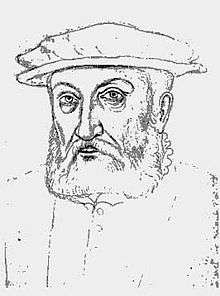Philippe II de Croÿ
Philip II de Croÿ (1496–1549) was Seigneur de Croÿ, Count of Porcéan and first Duke of Aarschot.

(by Jacques Le Boucq).
Philip belonged to the powerful House of Croÿ. He was the eldest son of Henry de Croy, and Charlotte de Châteaubriand.[1] His grandfather was Philip I of Croy, his uncle William II de Croÿ, chief tutor and First Chamberlain to Charles V, and his younger brothers were William, Archbishop of Toledo, and Robert, Prince-Bishop of Cambrai.
Philippe II de Croÿ succeeded to the County of Porcéan upon his father's death in 1514. In 1521 he inherited the titles of his uncle William : amongst others, Duke of Soria and Archi, and Count of Beaumont.
Like his predecessors, he was Governor of Hainault and Senior Knight of the Order of the Golden Fleece, but it is as Charles V's general that he is best remembered. He fought against the French in the Italian War of 1521–1526, and played an important role in the conquest of Tournai (1521).[2]
On April 1, 1533 Charles V created Philippe ("our cousin", as he styled him) Duke of Aarschot[3] and Grandee of Spain First Class. Earlier, he had become Marquess of Renty and exchanged the lordship of Longwy in Lorraine for that of Havré, which his descendants would develop as a family nest.
Marriage and children
His first wife was a distant cousin, Anne de Croÿ (1502–1539), Princess of Chimay, daughter of Charles I de Croÿ and great granddaughter of Jean II de Croÿ, Count of Chimay.
They had six children:
- Charles II (1522–1551), 2nd Duke of Aarschot, 3rd Prince of Chimay, 3rd Count of Beaumont
- Louise (1524–1585), married Maximilian of Burgundy, Marquis de Vere et de Vlissingen (died 1558) and John of Burgundy, Lord of Sommelsdijk (died 1586).
- Philippe III (1526–1595), 3rd Duke of Aarschot, 4th Prince of Chimay, 4th Count of Beaumont
- William (1527–1565), 2nd Marquis de Renty, one daughter Anne de Croy d. 1609
- Antoine (1530–1530)
- Louis (1533–1533)
Nine years after Anna's death, Philippe married Anna of Lorraine (1522–1568),[4] daughter of Antoine, Duke of Lorraine and widow of René of Châlon. They had one son, born after Philippe's death:
- Charles Philippe de Croÿ, Marquis d’Havré (1549–1613), had issue
References
- Bietenholz & Deutscher 1985, p. 368.
- Geevers & Marini 2015, p. 95.
- Polt 1989, p. 178.
- Israel 1997, p. 13.
Sources
- Bietenholz, Peter G.; Deutscher, Thomas Brian, eds. (1985). "Philip de Croy". Contemporaries of Erasmus: A Biographical Register of the Renaissance and Reformation. Vol. I. University of Toronto Press.CS1 maint: ref=harv (link)
- Geevers, Liesbeth; Marini, Mirella, eds. (2015). Dynastic Identity in Early Modern Europe: Rulers, Aristocrats and the Formation of Identities. Ashgate Publishing.CS1 maint: ref=harv (link)
- Israel, Jonathan I. (1997). Conflicts of Empires: Spain, the Low Countries and the Struggle for World Supremacy, 1585-1713. The Hambledon Press.CS1 maint: ref=harv (link)
- Polt, J. H. R. (1989). "More on Valera's "Nescit Labi Virtus"". Romance Notes. University of North Carolina at Chapel Hill. Vol. 30, No. 2 Winter.CS1 maint: ref=harv (link)
External links
- Marek, Miroslav. "genealogy". Genealogy.EU.
- genealogy (in French)